读书《从优秀到卓越》共50页文档
从优秀到卓越.未删节版].Good.To.Great.-.Jim.Collins
![从优秀到卓越.未删节版].Good.To.Great.-.Jim.Collins](https://img.taocdn.com/s3/m/1301db61ddccda38376baf21.png)
Good to Great “Why Some Companies Make the Leap... and Others Don’t"Harper Business, 2001, New York, NY.Review By-Swarup BoseTable of ContentsAbout the Author (3)Thesis (3)Chapter 1. Good is the Enemy of Great (4)Chapter 2.Level 5 Leadership (5)Chapter 3. First Who....Then what.. (6)Chapter 4. Confront the brutal facts (7)Chapter 5. Hedgehog Concept (9)Chapter 6. Cultural Discipline (10)Chapter 7. Technological Accelerators (11)Chapter 8. The Flywheel And the Doom Loop (12)Chapter 9. From Good To great To built to Last (14)Learnings from Good to great (15)Critique (16).About the Author :Jim Collins is a student and teacher of enduring great companies -- how they grow, how theyattain superior performance, and how good companies can become great companies. Havinginvested over a decade of research into the topic, Jim has co-authored three books, including theclassic Built to Last, a fixture on the Business Week bestseller list for s eliminated wastefulluxuries, like executive dining rooms, corporate jets, lavish vaca tion spots, etc., for the good ofthe co mpany - to other people, external factors, and good luck. All 11 of the featured companieshad this type of leadership, charactmulti-year research projects and works with executives fromthe private, public, and social sectors.Jim has served as a teacher to senior executives and CEOs at corporations that include: StarbucksCoffee, Merck, Patagonia, American General, W.L. Gore, and hundreds more. He has alsoworked with the non-corporate sector such as the Leadership Network of Churches, JohnsHopkins Medical School, the Boys & Girls Clubs of America and The Peter F. DruckerFoundation for Non-Profit Management. Jim invests a significant portion of his energy in large-scale research projects -- often five or moreyears in duration -- to develop fundamental insights and then translate those findings into books,articles and lectures. He uses his management laboratory to work directly with executives and todevelop practical tools for applying the concepts that flow from his research.In addition, Jim is an avid rock climber and has made free ascents of the West Face of El Capitanand the East Face of Washington Column in Yosemite Valley.Thesis :Collins and his team identified 11 companies that followed a pattern of "fifteen-year cumulativestock returns at or below the general stock market, punctuated by a transition point, thencumulative returns at least three times the market over the next fifteen years." Public companieswere selected because of the availability of comparable data. Fifteen-year segments were selectedto weed out the one-hit wonders and luck breaks. While these selection criteria exclude "neweconomy" companies, Collins contends that there is nothing new about the new economy, citingearlier technology innovations of electricity, the telephone, and the transistor.Having identified the companies that made the leap from Good To Great, Collins and his team setout to examine the transition point. What characteristics did the Good To Great companies havethat their industry counterparts did not? What didn't the Good To Great companies have?Collins maps out three stages, each with two key concepts. These six concepts are the heart ofGood To Great and he devotes a chapter to explaining each of them.• Level 5 Leadership• First Who... Then What• Confront the Brutal Facts• The Hedgehog Concept• A Culture of Discipline• Technology AcceleratorsCollins characterizes the Level 5 leader, as "a paradoxical blend of personal humility and professional will." The Level 5 leader is not the "corporate savior" or "turnaround expert". Mostof the CEOs of the Good To Great companies as they made the transition were company insiders.They were more concerned about what they could "build, create and contribute" than what theycould "get - fame, fortune, adulation, power, whatever". No Ken Lay of Enron or Al Dunlap ofScott Paper, the larger-than-life CEO, led a Good To Great company. This kind of executive is "concerned more with their own reputation for personal greatness" than they are with "setting the company up for success in the next generation".In this book, Jim Collins also challenges the notion that "people are your most important asset"and postulates instead that "the right people are." I don't know that I yet completely agree with his philosophy that it's more important to get the right people on the bus and then see where it goesthan it is to figure out where to go and get the right people on the bus who can get you there. However, he makes his point clearly and you can decide if you agree with him.This nearly 300-page book is packed with leading edge thinking, clear examples, and data to support the conclusions. It is a challenge to all business leaders to exhibit the discipline requiredto move their companies from Good To Great.Chapter 1: Good is the Enemy of GreatCollins and his assembled crew started their research using the companies that rank in the top 500in total annual sales. Then, by analyzing the returns they narrowed down the list to companiesthat experienced mediocrity for a period of time, but then changed course for the better and outperformed not just other companies in the same industry, but the overall market by several times. Other factors were also considered, until they finally had the list narrowed down to eleven “superstar” corporations: Abbott, Circuit City, Fannie Mae, Gillette, Kimberly- Clark, Kroger, Nucor, Phillip Morris, Pitney Bowes, Walgreens, and Wells Fargo. He then explored what goesinto a company’s transformation from mediocre to excellent. Based on hard evidence and volumes of data, the book author (Jim Collins) and his team uncovered timeless principles on how the good-to-great companies like produced sustained greatresults and achieved enduring greatness, evolving into companies that were indeed ‘Built to Last’.Good to Great is centers on a comparative analysis of eleven companies. Collins selects once-dull organizations, such as Kimberley Clark and Gillette that subsequently outperformed.The usual fault of such manuals is their obvious prescriptions. Of course successful firms keptclose to their customers and motivated employees. But unsuccessful firms didn’t fail because they rejected these objectives. They failed because they couldn’t achieve them. Collins penetrates these banalities because he questions the congratulatory self-description of winning businesses. For example, most of his eleven companies didn’t have visionary CEOs determined to turn the business round Few were aiming at the cover page of Fortune, most were consensus builders from inside the organization. Collins' research says the CEO's at the time companies become great aren't egotistical business leaders. Rather, they tend to be reserved people who channel their ego into building their companies. Collins is a little vague on exactly how you get other employees and key players tochannel their egos into building the company. The hope is that, if you select the right people, they'll do what's best for the company rather than for themselves.Finding something you can be passionate about is the other key. And, all employees must be passionate about the endeavor. Because most employees won't get jazzed about making the CEO and shareholders wealthy, a company should have a purpose beyond just making money. Collins says a company should have 'core values.'Collins says it doesn't matter what these 'core values' are, just that they exist. He says Philip Morris is happy to provide the strongest brand recognition of 'sinful' products. Maybe, they're rebelling against political correctness, or health, or whatever. If it works for them, it's cool. Fannie Mae, on the other hand, prides itself on providing mortgages to new, less-affluent homeowners and helping people buy homes. That sounds good, and is probably true, but it reads a little bit like a publicity statement.Chapter 2: Level 5 Leadership In this chapter Collins describes what he refers to as “level 5” leadership as explained in the table below. Every good-to-great company had “Level 5” leadership during pivotal transition years, where Level 1 is a Highly Capable Individual, Level 2 is a Contributing Team Member, Level 3 is the Competent Manager, Level 4 is an Effective Leader, and Level 5 is the Executive who builds enduring greatness through a paradoxical blend of personal humility and professional will. Level 5 leaders display a compelling modesty, are self-effacing and understated. In contrast, two thirds of the comparison companies had leaders with gargantuan personal egos that contributed to the demise or continued mediocrity of the company. Level 5 leaders are fanatically driven, infected with an incurable need to produce sustained results. They are resolved to do whatever it takes to make the company great, no matter how big or hard the decisions. One of the most damaging trends in recent history is the tendency (especially of boards of directors) to select dazzling, celebrity leaders and to de-select potential Level 5 leaders. Potential Level 5 leaders exist all around us, we just have to know what to look for. The research team was not looking for Level 5 leadership, but the data was overwhelming and convincing. The Level 5 discovery is an empirical, not ideological, finding.The 5th Level Leader – 5th Level Leaders have a combination of strong will and personal humility. The 5th Level Leader demonstrates an unwavering resolve and sets the standard for building great companies. In balance, he/she demonstrates a compelling modesty, relies on inspired standards and channels ambition into the company, and not into the self. The 5th Level Leader “looks in the mirror, not out the window” when focusing on responsibility and does just the opposite when apportioning credit for success of the company.When a leader’s energy is “in balance” they are driven neither by ego nor fear. They are moving at a speed that allows them to feel themselves, as well as those around them. They realize more than anyone else, that “the less you control, the more you can do”. Leadership greatness is about being a conduit of energy, not a single generator of it.Collins asked a critical question: Can 5th Level Leadership be taught? Well, yes and no. To the extent someone is gifted with these innate capabilities, they certainly have a head start. For any leader it is a matter of degree. It is about growing into the role of a 5th Level Leadership leader.It is interesting to note that most 5th Level Leaders did not live extravagant lifestyles. They had sound family and community relationships. They had healthy and long-term marriages. Most of them are highly spiritual people who have attributed much of their success to good-luck and God rather than personal greatness. These men and women were servant leaders, not self-serving ones.The five levels are as follows :Level 5 ExecutiveBuilds enduring greatness through a paradoxical blend of personal humility and professional will. Level 4Effective LeaderCatalyzes commitment to and vigorous pursuit of a clear and compelling vision, stimulating higher performance standards.Level 3Competent ManagerOrganizes people and resources towards the effective and efficient pursuit of predetermined objectives.Level 2Contributing Team MemberContributes individual capabilities to the achievement of group objectives and worked effectively with others in a group setting.Level 1Highly Capable IndividualMakes productive contributions through talent, knowledge skills, and good work habits.Humility + Will = Level 5Professional Will and Personal Humility creates superb results, a clear catalyst in the transition from good to great. Demonstrates a compelling modesty, shunning public adulation; never boastful. Demonstrates an unwavering resolve to do whatever must be done to produce the best long-term results, no matter how difficult. Acts with quiet, calm determination; relies principally on inspired standards, not inspiring charisma, to motivate. Sets the standard of building an enduring great company; will settle for nothing less. Channels ambition into the company, not the self; sets up successors for even greater success in the next generation. Looks into the mirror, not out the window, to apportion responsibility for poor results, never blaming other people, external factors, or bad luck. Looks out the window, not in the mirror, to apportion credit for the success of the company - to other people, external factors, and good luck.All 11 of the featured companies had this type of leadership, characterized by a CEO who displayed determination and a strong will to be the best, yet who also showed humility. These level 5 leaders eliminated wasteful luxuries, like executive dining rooms, corporate jets, lavish vacation spots, etc., for the good of the company. Also, when asked about the success of the company, they were quick to give complete credit to the other workers in the company, rather than themselves. Yet these CEOs rose above their peers. Collins dubs them "Level 5" managers. By this definition, each was humble to a fault and hid from the limelight. At the same time, though, all of them went to extraordinary lengths to make their companies great. For Darwin E. Smith of Kimberly-Clark, that required jettisoning the core business when he sold its paper mills. For George Cain at Abbott, it meant firing his own relatives. These leaders' ambition was "first and foremost for the company," writes Collins. They were "concerned with its success, rather than their own riches and personal renown." Chapter 3: First Who ... then WhatIt deals with confronting the facts of expertise and market know- how, and then assembling together a first- class team of dedicated workers and management to achieve goals. In these “goodto great” companies, they all shared several things in common. First and foremost, they were not afraid to admit that they lacked the necessary skills to succeed in certain markets. Instead of pretending to know everything, these companies brainstormed until they had a short list of what they knew they could do better than anyone else. They didn’t bother acquiring other companies, where they had no expertise, or trying to learn new skills, or anything like that. Instead, they focused in on what they were best at, then hired individuals who were skilled in the same area and who would be most likely to work relentlessly toward a goal. Collins' point is "...not just about assembling the right team - that's nothing new. The main pointis to first get the right people on the bus (and the wrong people off the bus) before you figure out where to drive it. The second key point is the degree of sheer rigor needed in people decisions in order to take a company from good to great.". Regarding people decisions he has the following to say:1. When in doubt, don't hire - keep looking. (Corollary: A company should limit its growthbased on its ability to attract enough of the right people.)2. When you know you need to make a people change, act. (Corollary: First be sure youdon't simply have someone in the wrong seat.)3. Put your best people on your biggest opportunities, not your biggest problems.(Corollary: If you sell off your problems, don't sell off your best people.)Good-to-great leaders understand three simple truths:If you begin with the “who,” rather than the “what,” you can more easily adapt to a changing world.If you have the right people on the bus, the problem of how to motivate and manage people largely goes away.If you have the wrong people, it doesn’t matter whether you discover the right direction—you still won’t have a great company. Great vision without great people isirrelevant.Chapter 4: Confront the Brutal FactsThis chapter deals with the Stockdale Paradox .Another defiance of conventionality is encapsulated in the so-called Stockdale paradox. Admiral Stockdale survived a long period of imprisonment in Vietnam. He had determination to survive, but claimed that it was ‘the optimists’ who failed to see it through. The Stockdale paradox contrasts those who focus with determinationon a realistic objective with the fantasists whose slogan is that if you can dream it, you can do it. Retrain faith that you will prevail in the end, regardless of the difficulties and at the same time confront the most brutal facts of your current reality, whatever they might be. It says:1. Lead with questions, not answers2. Engage in dialogue and debate, not coercion.3. Conduct autopsies, without blame.4. Build red flag mechanisms that turn information into information that cannot be ignored.Next, even before they had settled on a business plan, these CEOs surrounded themselves with smart, hard-working people who were not afraid to face their shortcomings and hurdles--the "brutal facts," as Collins puts it--but who had faith they would ultimately win. After settling on a course, the companies on the list never lost sight of what they did best, and they maintained tough standards for their people. New hires either fit right in--or were quickly ejected. Then, through perseverance and the careful use of technology, the enterprises lifted off. "The process resembles relentlessly pushing a giant heavy flywheel in one direction, turn upon turn, building momentum until a point of breakthrough, and beyond," Collins concludes. Good-to-Great companies maintain unwavering faith that they can and will prevail in the end, regardless of the difficulties, and at the same time have the discipline to confront the most brutal facts of their current reality – whatever that might be.All good-to-great companies began the process of finding a path to greatness by confronting the brutal facts of their current reality. When a company starts with an honest and diligent effort to determine the truth of its situation, the right decisions often become self-evident. Good decisions are impossible without an honest confrontation of the brutal facts.Why Kroger Beat A&PThe Great Atlantic and Pacific Tea Company (also known as A&P) had the perfect business model for the first half of the twentieth century, when two world wars and an economic depression imposed frugality upon Americans: cheap, plentiful groceries sold in utilitarian stores. However, in the more affluent second half of the century, Americans began demanding bigger stores, more choices, fresh baked goods, fresh flowers, banking services and so forth. They wanted superstores that offered almost everything under one roof. To f ace the brutal facts about the mismatch between its past model and the changing world, A&P opened a new store called Golden Key, where it could experiment with new methods and models and learn what customers wanted. It sold no A&P-branded products, experimented with new departments, and began to evolve toward the more modern superstore. A&P began to discover the answer to the questions of why it was losing market share and what it could do about it. But A&P executives didn’t like the answers they got, so they closed the store, rather than diverge from their ages-old business ideas. Meanwhile, the Kroger grocery chain also conducted experiments and, by 1970, discovered the inescapable truth that the old-model grocery store was going to become extinct. Rather than ignore the brutal truth, as A&P did, the company acted on it, eliminating, changing, or replacing every single store that did not fit the new realities. It went block-by-block, city-by-city, state-by- state, until it had rebuilt its entire system. By 1999, it was the number one grocery chain in America.Let the Truth Be HeardOne of the primary tasks in taking a company from good to great is to create a culture wherein people have a tremendous opportunity to be heard and, ultimately, for the truth to be likewise heard. To accomplish this, you must engage in four basic practices:Lead with questions, not answers.Leading from good to great does not mean coming up with the answers and motivating everyone to follow your messianic vision. It means having the humility to grasp the fact that you do not yet understand enough to have the answers, and then to ask questions that will lead to the best possible insights.Engage in dialogue and debate, not coercion.All good-to-great companies have a penchant for intense debates, discussions and healthy conflict. Dialogue is not used as a sham process to let people “have their say” so they can buy into a predetermined decision; rather, it is used to engage people in the search for the best answers.Conduct autopsies, without blame.Good-to-great leaders must take an honest look at decisions his or her company makes, rather than simply assigning blame for the outcomes of those decisions. These “autopsies” go a long way toward establishing understanding and learning, creating a climate where the truth is heard.Build red flag mechanisms that turn information into information that cannot be ignored.Good-to-great companies have no better access to information than any other company; they simply give their people and customers ample opportunities to provide unfiltered information and insight that can act as an early warning for potentially deeper problems. Chapter 5 : The Hedgehog ConceptIt talks about the triumph of understanding over bravado -- requires a deep understanding of three intersecting circles translated into a simple, crystalline concept -- the hedgehog concept.and it’s the basis for much of the book. This concept involves reflecting on three important questions that all businesses should ask:1. What are you deeply passionate about?2. What drives your economic engine? and3. What you can be best in the world at ?At what you can be best in the world. This standard goes far beyond core competence — just because you possess a core competence doesn’t necessarily mean you are the best in the world at that competence. Conversely, what you can be best in the world at might not even be something in which you are currently engaged. The Hedgehog Concept is not a goal or strategy to be the best at something; it is an understanding of what you can be the best at and, almost equally important, what you cannot be the best at.What drives your economic engine? To get insight into the drivers of your economic engine, search for the one denominator (profit per x, for example, or cash flow per x) that has the single greatest impact. If you could pick one and only one ratio to systematically increase over time to make a greater impact, what would that ratio be? This denominator can be subtle, sometimes even unobvious. The key is to use the denominator to gain understanding and insight into your economic model.What you are deeply passionate about. Good-to-great companies did not pick a course of action, then encourage their people to become passionate about their direction. Rather, those companies decided to do only those things that they could get passionate about. They recognized that passion cannot be manufactured, nor can it be the end result of a motivation effort. You can only discover what ignites your passion and the passions of those around you.These three questions are placed within overlapping circles. The area where the three overlap is the area where a corporation should aim to reach, to ensure the most output and the greatest efficiency..A hedgehog concept is not a goal to be the best, a strategy to be the best, an intention to be the best, a plan to be the best. It is an understanding of what you can be the best at.If you could pick one and only one ratio - profix per x (or in the social sector, cash flow per x) - to systematically increase over time, what x would have the greatest and most sustainable impact on your economic engine?The core of the book emphasizes what Collins refers to as a 'hedgehog' strategy that is necessary to achieve greatness. Collins says great companies are like hedgehogs in that they stick to what they know and can do well. Collins says when a fox attacks a hedgehog the hedgehog curls into a prickly ball and the attacking fox must leave it alone. Then, the fox runs around and tries another point of attack and never learns. The hedgehogs only need to do one thing that works well and consistently. In short, after much research and writing, Collins finds the key to business success is functioning within the intersection of three circles. The first circle represents an endeavor atwhich your company has the potential to be the best in the world. The second circle represents what your company can feel passionate about. The third circle represents a measure of profitability that can drive your economic success. You must choose to do something that's profitable and know how to focus upon that profitability.To find the circles, Collins makes the excellent point that you must begin with the right people. Collins emphasizes that the people must come before you decide exactly how your company will achieve success. We learn that in great companies there is often heated debate about what's best for the company. The culture of great companies is open in the sense that the truth will be heard. That's very different from debating for the sake of protecting private turf and self-aggrandizement.Chapter 6 : Cultural DisciplineThis chapter deals with the importance of discipline. It talks about building a culture full of self-disciplined people who take disciplined action, fanatically consistent with the three circles, the hedgehog concept. freedom and responsibility within a framework -- build a consistent system with clear constraints, but give people freedom and responsibility within the framework of that system. It advises to hire self-disciplined people who don't need to be managed, and to manage the system, not the people.Discipline means fanatical adherence to the Hedgehog Concept and the willingness to shun opportunities that fall outside the three circles. The findings here might surprise some people. First of all, the management teams of the best companies are not strict disciplinarians. Discipline is stressed, but it comes from hiring employees who are already disciplined and ready to motivate themselves to achieve. Bureaucratic culture arises to compensate for incompetence and lack of discipline, which arise from having the wrong people on the bug in the first placeHaving a disciplined culture is the opposite of having a controlled one. There is no need for hierarchy, bureaucracy, or excessive control. Sustained great results depend upon building a culture full of self-disciplined people who take disciplined action fanatically consistent with the three circles of the Hedgehog Concept. This is in contrast to the typical ways in which many companies (particularly start-ups) conduct themselves when responding to growth and success. As these companies grow, they tend to sacrifice the creativity, energy and vision that made them successful in favor of hierarchical, bureaucratic structures and strictures — thus killing the entrepreneurial spirit as they create order. Exciting companies thus transform themselves into ordinary companies, and mediocrity begins to grow in earnest. Indeed, bureaucratic cultures arise to compensate for incompetence and lack of discipline, which arise from having the wrong people on the bus in the first place. Most companies build their bureaucratic rules to man-age a small percentage of the wrong people, which in turn drives away the right people. This self-perpetuating problem can be avoided by creating a culture of discipline.Action StepsTo create a culture of discipline, you must:Build a culture around the idea of freedom and responsibility, within a framework.Good-to-great companies built a consistent system with clear constraints, but they also gave people freedom and responsibility within the framework of that system. They hired self-disciplined people who didn’t need to be managed, and then managed the system, not the people. They also had the discipline of thought, to confront the brutal facts of reality and still maintain faith that they were on the track to greatness. Finally, they took disciplined actions that kept them on that track.。
从优秀到卓越—4

《从优秀到卓越》
通过一个月的从卓越到优秀这本书的阅读,与书中的那句:要成为一个卓越的企业,首先要秉承先人后事的观念,特别是对于领导人的特质描写。
极端谦逊加绝对专业,让我印象特别深刻。
对于先人后事,书中也提到了对于管理者的重要性,要寻找合适的经理人,宁缺毋滥。
从提出为什么要实现卓越,到分为三个方面来阐述,第一是选择有意义的工作,第二是要从事在乎的事业,第三是寻追寻人生与存在的意义。
面提到的从事在乎的事业,让我感触颇深,因为你热爱这份工作,在工作中所遇到的任何问题,都会自己去努力去解决,会想应该如何做,这是成为一个优秀的人的基础。
另一个让我感触颇深的是,创造一个让事实说话的大气候,有四个注意的基本点,第一是多提些问题,少要求答案,第二是要对话,要争执,但不要强制,第三是做彻底的事后分析,不要相互指责,第四是建立红旗机制,把信息转化为无法被忽视的信息。
为什么要说要多提问题,只有提问题,才会让当前存在的问题才会浮出水面。
而在发言的过程中经常会有争论,我们要让整个过程更像一个科学性的争论,让公司在争吵和战斗中前进。
目前我只看到第四章,后面我将继续学习。
《从优秀到卓越》读后感读书笔记五篇

《从优秀到卓越》读后感读书笔记五篇----WORD文档,下载后可编辑修改----篇一:《从优秀到卓越》读后感冰冻三尺非一日之寒,企业从优秀到卓越的跨越,都是经过了大量的积累,在有充分准备的基础上进行的变革。
“台上一分钟,台下十年功”。
没有对所从事事业的不断学习、创新、积淀的过程,就不可能在别人的眼中绽放出耀眼的光芒,都不可能创造出奇迹。
我们所看到的美好瞬间,背后都包含了艰辛的磨练和艰难的过程。
《从优秀到卓越》是美国作者吉姆柯林斯所著,这是柯林斯继《基业长青》之后又一管理力作,是一本关于“成功之后如何更成功”的著作。
柯林斯和他的21人工作研究小组运用半年时间把30多年间出现在《财富》500强排行榜上的企业进行逐一分析,从1435家公司中筛选出11家取得巨大成功的企业,并与那些实现跨越却并不能持久的公司(柯林斯称之为间接对照公司)或未能实现跨越的公司(柯林斯称之为直接对照公司)进行对照分析,发现了从优秀到卓越的内在机制和决定性因素。
作者具体围绕训练有素的人、训练有素的思想、训练有素的行为三方面展开分析。
他并没有以当事人的角度灌输给读者他自认为的信条,而是以第三者的理性来看待这件事情,以数据和事实说话。
公司从优秀到卓越,跟从事的行业是否是朝阳行业没有关系,跟合并、收购等企业重组没有关系,跟技术变革没有太大的关系,而与管理者及其决策有根本的关系。
从优秀到卓越的答案“不受时间、地域的限制,普遍适用于任何机构”。
柯林斯为我们拨开迷雾:那些业绩卓越的公司之所以卓越,并不是因为“他们比常人更聪明、更有魅力、更有创造力和有更高深的思想”,他们也“并不一定比我们更善于想出好点子”。
卓越企业的基因或许在任何一个一般的企业身上都可能出现过,所不同的是,卓越企业能把这些理念和原则坚持得更加彻底。
自工业社会以来,追求卓越注定成为每个企业家的梦想,卓越的企业也一直成为每个企业家效仿和追捧的对象。
在这本著作中,作者诠释了关于卓越的三个问题:一、为什么要从优秀做到卓越?当一滴水遇到海洋,慨叹海洋的广阔是因为她走过了小溪、江河,有了比较才知道什么是更大更广。
《从优秀到卓越》全书简介

《从优秀到卓越》全书简介《从优秀到卓越》作者:【美】吉姆.柯林斯这本书不会使平庸的公司成为优秀的公司。
但是,它却使优秀的公司成为卓越的公司。
——彼得.德鲁克一个作者在出版了成名作之后,若想再辉煌,往往像跳高动员要想打破自己的记录一样困难重重。
但那时,吉姆.柯林斯是个例外。
1994年他和杰里.波拉斯出版了《基业长青》这本20世纪90年代的管理力作后,2001年年初又出人意料地推出了一力作——《从优秀到卓越》。
《基业长青》对美国一些大公司永续成功经营的深层原因进行了探索,得出的结论真实可信,具有很大的现实指导意义。
该书出版后的第2年即被《产业周刊》评为1995年头号商业畅销书,《今日美国》更是称其为“继《追求卓越》之后最引人瞩目的企业研究力作。
”《华尔街日报》称其为“一本异乎寻常的书,很值得一读。
”目前它的英文版重印超过70次,销售100多万册,并且已被译成16种外文在全球发行。
简单地说,《基业长青》说明了卓越的公司为何历经上百年而长盛不衰,它们又是如何从创业时就将长期可持续的业绩注入企业的DNA这样一个道理。
但是,生来并不具备卓越的DNA公司怎么办?优秀的公司,一般性的公司,甚至是很糟糕的公司,怎么成为一个能持续创造非凡业绩的企业?为什么有的公司实现了大跨越,而别的公司却没有?在长达5年的时间里,这个问题一直困扰着柯林斯的头脑。
哪些公司可以摆脱平庸的万有引力,从大众化的沼泽中脱颖而出,实现长期的卓越?如果那样的话,这些公司又具有哪些普遍的显著特征,使得它们能够从优秀转变为卓越的呢?怀着这样的好奇心和追求真理的决心,柯林斯和他的21人的研究小组,对1965年至1995年30年间出现在《财富》500强排行榜上的1435家企业进行了逐一分析,找到11家企业,它们实现了从优秀业绩到卓越业绩的跨越,并保持15年以上。
在此期间,这些公司的平均股票收益是大盘股指的6.9倍,而像通用电气这样的超级公司也只有2.8倍。
《从优秀到卓越》读书笔记
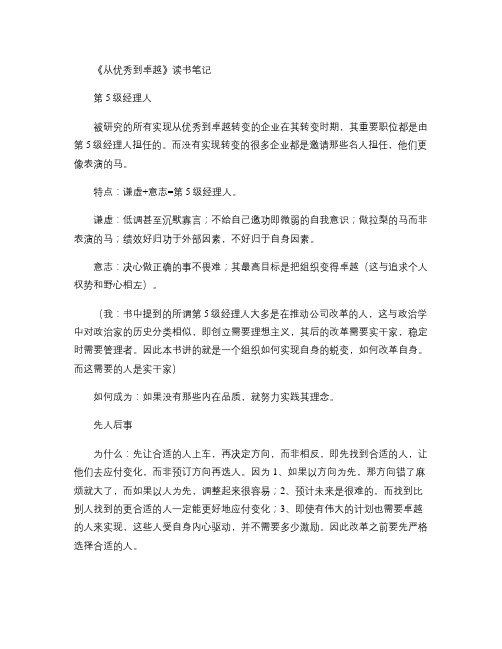
《从优秀到卓越》读书笔记第5级经理人被研究的所有实现从优秀到卓越转变的企业在其转变时期,其重要职位都是由第5级经理人担任的。
而没有实现转变的很多企业都是邀请那些名人担任,他们更像表演的马。
特点:谦虚+意志=第5级经理人。
谦虚:低调甚至沉默寡言;不给自己邀功即微弱的自我意识;做拉梨的马而非表演的马;绩效好归功于外部因素,不好归于自身因素。
意志:决心做正确的事不畏难;其最高目标是把组织变得卓越(这与追求个人权势和野心相左)。
(我:书中提到的所谓第5级经理人大多是在推动公司改革的人,这与政治学中对政治家的历史分类相似,即创立需要理想主义,其后的改革需要实干家,稳定时需要管理者。
因此本书讲的就是一个组织如何实现自身的蜕变,如何改革自身。
而这需要的人是实干家)如何成为:如果没有那些内在品质,就努力实践其理念。
先人后事为什么:先让合适的人上车,再决定方向,而非相反,即先找到合适的人,让他们去应付变化,而非预订方向再选人。
因为1、如果以方向为先,那方向错了麻烦就大了,而如果以人为先,调整起来很容易;2、预计未来是很难的,而找到比别人找到的更合适的人一定能更好地应付变化;3、即使有伟大的计划也需要卓越的人来实现,这些人受自身内心驱动,并不需要多少激励。
因此改革之前要先严格选择合适的人。
“使用方法”:对于一个组织来说,一个天才加一百个助手的模式不可持续,要把适合的人放在适合的位置,发挥群体的智慧(包括定方向)。
在一个问题上大家可能吵得不可开交,有暴力倾向,但一旦群体做出决策就不再计较个人得失。
(我:这样一来,领导最重要的事就是识别人才与协调,而非自己的才能,虽然这也很重要。
事实上,书中提到一些领导人把大部分精力花在发现寻找合适人上)谁是合适的人:最重要的不是怎样激励,而是给谁激励。
人力资源不是最宝贵的资源,合适的雇员才是。
那些为了狭隘个人利益而工作的人不是合适的人,渴望工作、创造价值、勤奋、不那么在意薪酬是基本的满足“合适”的条件,薪酬对他们只是解决后顾之忧,是最基本的,但仅用这个去激励他们是不够的。
读后感《从优秀到卓越》
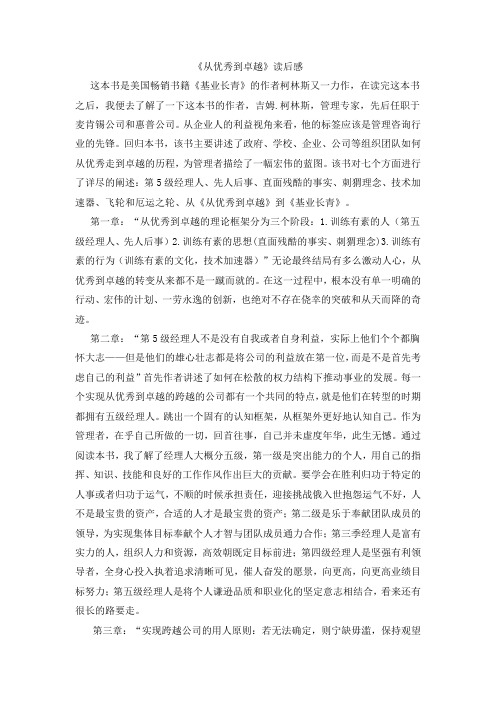
《从优秀到卓越》读后感这本书是美国畅销书籍《基业长青》的作者柯林斯又一力作,在读完这本书之后,我便去了解了一下这本书的作者,吉姆.柯林斯,管理专家,先后任职于麦肯锡公司和惠普公司。
从企业人的利益视角来看,他的标签应该是管理咨询行业的先锋。
回归本书,该书主要讲述了政府、学校、企业、公司等组织团队如何从优秀走到卓越的历程,为管理者描绘了一幅宏伟的蓝图。
该书对七个方面进行了详尽的阐述:第5级经理人、先人后事、直面残酷的事实、刺猬理念、技术加速器、飞轮和厄运之轮、从《从优秀到卓越》到《基业长青》。
第一章:“从优秀到卓越的理论框架分为三个阶段:1.训练有素的人(第五级经理人、先人后事)2.训练有素的思想(直面残酷的事实、刺猬理念)3.训练有素的行为(训练有素的文化,技术加速器)”无论最终结局有多么激动人心,从优秀到卓越的转变从来都不是一蹴而就的。
在这一过程中,根本没有单一明确的行动、宏伟的计划、一劳永逸的创新,也绝对不存在侥幸的突破和从天而降的奇迹。
第二章:“第5级经理人不是没有自我或者自身利益,实际上他们个个都胸怀大志——但是他们的雄心壮志都是将公司的利益放在第一位,而是不是首先考虑自己的利益”首先作者讲述了如何在松散的权力结构下推动事业的发展。
每一个实现从优秀到卓越的跨越的公司都有一个共同的特点,就是他们在转型的时期都拥有五级经理人。
跳出一个固有的认知框架,从框架外更好地认知自己。
作为管理者,在乎自己所做的一切,回首往事,自己并未虚度年华,此生无憾。
通过阅读本书,我了解了经理人大概分五级,第一级是突出能力的个人,用自己的指挥、知识、技能和良好的工作作风作出巨大的贡献。
要学会在胜利归功于特定的人事或者归功于运气,不顺的时候承担责任,迎接挑战俄入世抱怨运气不好,人不是最宝贵的资产,合适的人才是最宝贵的资产;第二级是乐于奉献团队成员的领导,为实现集体目标奉献个人才智与团队成员通力合作;第三季经理人是富有实力的人,组织人力和资源,高效朝既定目标前进;第四级经理人是坚强有利领导者,全身心投入执着追求清晰可见,催人奋发的愿景,向更高,向更高业绩目标努力;第五级经理人是将个人谦逊品质和职业化的坚定意志相结合,看来还有很长的路要走。
吉姆·柯林斯《从优秀到卓越》(78张PPT)
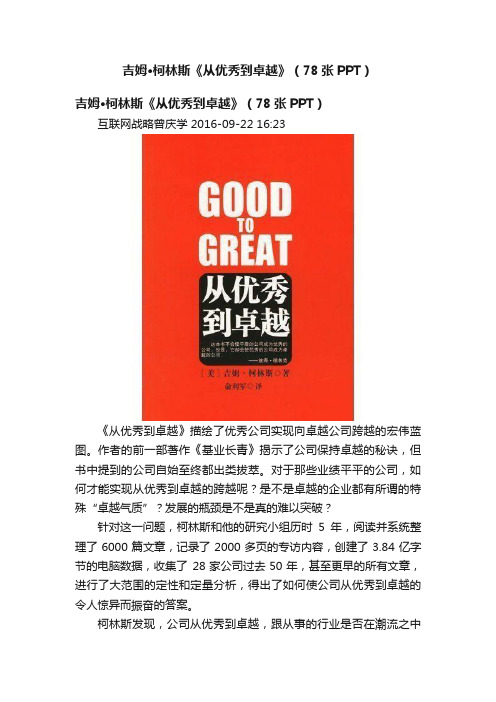
吉姆·柯林斯《从优秀到卓越》(78张PPT)
吉姆·柯林斯《从优秀到卓越》(78张PPT)
互联网战略曾庆学 2016-09-22 16:23
《从优秀到卓越》描绘了优秀公司实现向卓越公司跨越的宏伟蓝图。
作者的前一部著作《基业长青》揭示了公司保持卓越的秘诀,但书中提到的公司自始至终都出类拔萃。
对于那些业绩平平的公司,如何才能实现从优秀到卓越的跨越呢?是不是卓越的企业都有所谓的特殊“卓越气质”?发展的瓶颈是不是真的难以突破?
针对这一问题,柯林斯和他的研究小组历时5年,阅读并系统整理了6000篇文章,记录了2000多页的专访内容,创建了3.84亿字节的电脑数据,收集了28家公司过去50年,甚至更早的所有文章,进行了大范围的定性和定量分析,得出了如何使公司从优秀到卓越的令人惊异而振奋的答案。
柯林斯发现,公司从优秀到卓越,跟从事的行业是否在潮流之中
没有关系,事实上,即使是一个从事传统行业的企业,即使它最初默默无闻,它也可能卓越。
柯林斯提出了一整套观点,“只要采纳并认真贯彻,几乎所有的公司都能极大改善自己的经营状况,甚至可能成为卓越公司”。
从优秀到卓越
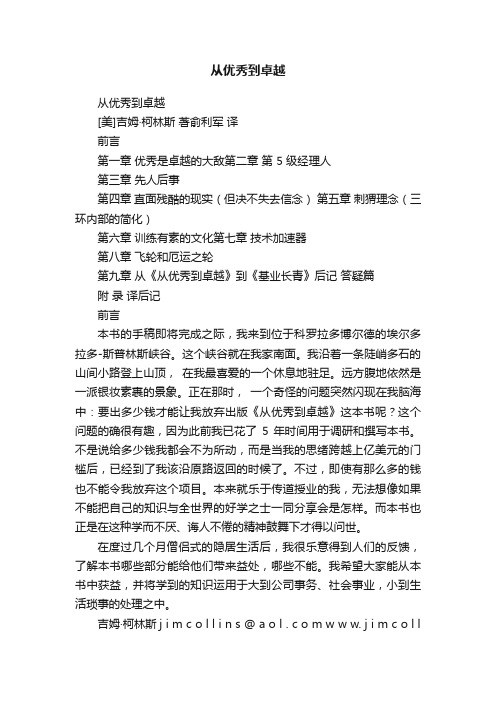
从优秀到卓越从优秀到卓越[美]吉姆·柯林斯著俞利军译前言第一章优秀是卓越的大敌第二章第 5 级经理人第三章先人后事第四章直面残酷的现实(但决不失去信念)第五章刺猬理念(三环内部的简化)第六章训练有素的文化第七章技术加速器第八章飞轮和厄运之轮第九章从《从优秀到卓越》到《基业长青》后记答疑篇附录译后记前言本书的手稿即将完成之际,我来到位于科罗拉多博尔德的埃尔多拉多-斯普林斯峡谷。
这个峡谷就在我家南面。
我沿着一条陡峭多石的山间小路登上山顶,在我最喜爱的一个休息地驻足。
远方腹地依然是一派银妆素裹的景象。
正在那时,一个奇怪的问题突然闪现在我脑海中:要出多少钱才能让我放弃出版《从优秀到卓越》这本书呢?这个问题的确很有趣,因为此前我已花了5 年时间用于调研和撰写本书。
不是说给多少钱我都会不为所动,而是当我的思绪跨越上亿美元的门槛后,已经到了我该沿原路返回的时候了。
不过,即使有那么多的钱也不能令我放弃这个项目。
本来就乐于传道授业的我,无法想像如果不能把自己的知识与全世界的好学之士一同分享会是怎样。
而本书也正是在这种学而不厌、诲人不倦的精神鼓舞下才得以问世。
在度过几个月僧侣式的隐居生活后,我很乐意得到人们的反馈,了解本书哪些部分能给他们带来益处,哪些不能。
我希望大家能从本书中获益,并将学到的知识运用于大到公司事务、社会事业,小到生活琐事的处理之中。
吉姆·柯林斯*********************.jimcolli n s . c o m科罗拉多州博尔德2 0 0 1 年3 月 2 7 日优秀是卓越的大敌“令死神望而却步的,是永无止境的好奇心。
”—贝里尔·马卡姆《乘夜向西》优秀是卓越的大敌。
这就是为什么鲜有优秀者实现卓越的主要原因。
我们没有卓越的学校,主要是因为我们有优秀的学校。
我们没有卓越的政府,大抵是因为我们有优秀的政府。
很少有人能过上美满的生活,基本原因是过上好生活很容易。
从优秀到卓越 修改版

已是优秀的公司有可能更上层楼成为卓越的公司吗? 如果可以,怎样才能做到?
卓越模型 第五级经理人 先人后事 直面残酷的现实 刺猬理论 强调纪律的文化
《从优秀到卓越》
揭开黑匣子里的秘密 空降的企业明星并不能领导公司从优秀到卓越。在十一家
“从优秀到卓越”的公司中,有十家公司的执行长都是由内部升迁 的。 行业并不重要。“从优秀到卓越”的公司大半并非从事卓越的 行业,有些产业甚至状况很糟。
先事后 人
卓越模型 第五级经理人 先人后事
先人后 事
直面残酷的现实 刺猬理论 强调纪律的文化
《从优秀到卓越》
先人后事的启示
1、只要还有疑虑,宁可暂不录用,继续寻找千里马
2、当你感到需要改革人事时,赶快采取行动
3、让最优秀的人才掌握公司最大的契机,而不是请他们去 解决公司最严重的问题
卓越模型
第五级经理人
卓越模型
第五级经理人
先人后事
直面残酷的现实
刺猬理论
强调纪律的文化
《从优秀到卓越》
塑造文化,而非推行暴政
• 从优秀到卓越”的公司里都有一位第五级领导人,建立起能长治久安的纪律文化 。反之,未能常保卓越的公司领导人通常只是第四级,他们施展铁碗,强力推行 组织纪律,在强人离开后却没能留下强调纪律的文化,或强人本身变得没纪律, 跨出三个圆圈的领域。 乐柏美的高尔特自称是真诚的独裁者。他为乐柏美树立了严格的纪律,如严谨的 规划和竞争者分析、系统化的市场研究、踏实的成本控制等。他自己做事也一丝 不苟、有条不紊。但纪律主要靠他一人维系,在他离开后乐柏美就开始走下坡路 。
卓越模型
第五级经理人
先人后事
直面残酷的现实
刺猬理论
强调纪律的文化
《从优秀到卓越》
《从优秀到卓越》学习课件
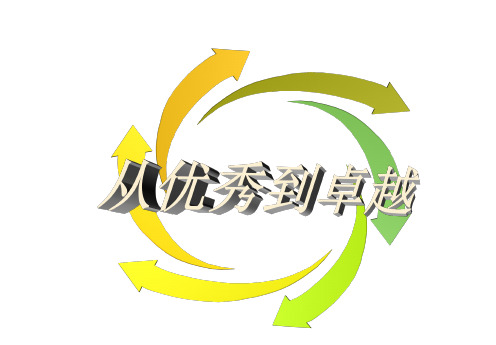
九、自我感想
卓越公司的经理人的表现
我们的表现
成功时:向窗外看而不是向镜子里看, 把公司的成功归结于别人、外因 和好运。 失败时:向镜子里看,而不是向窗外看, 业绩不佳时自己承担责任,而不是埋怨别 人,归咎于外因或运气不好。
我们不论是成还是败,总是爱照镜子, 结果就是让自己活得真是累。
经常为了企业的战略、战术、计划争吵得 不可开交,甚至于。。。
最佳 方式
你能在什么 方面成为世 界上最优秀的 是什么驱动 你的经济引擎
对“世界上最好的”的感悟,是比核心能力更为严格 的一个标准。你可能有竞争力,但是不一定有能力成 为世界上最优秀的。相反,在某些方面你可能成为世 界上最优秀的,但是在现阶段你在这方面没有竞争力。 要明白你的经济引擎的驱动力,必须寻找一个产生最 大影响的指标(每“X”利润,或在社会部门,每“X” 现金流)。
描述: 合适的人上车,不合适的人下车,然后决定将车开往何处。衡量某人是否“合适人选”, 主要看内在性格特征和天赋能力,而不是专门知识、背景或实际技能。
描述:(1)若仍不确定,则宁缺勿滥,保持观望态度(推论:限制公司发展的最终力量,取决于 你得到合适人才的多少)。(2)一旦发觉换人之举势在必行,就即刻行动(推论:首先必须确定, 你的问题不仅仅只是安排错了位置)。(3)将杰出人才用于抓住天赐良机,以图发展,而不是解 决你的“最大难题”(推论:如果你要解决问题,千万不可把你的优秀人才也解决掉了)。 描述:报酬的高低并不是公司是否卓越的关键;人力不是最重要的财富,合适的雇员才是; 对于哪些作过贡献的确人来说最大的嘉奖就是不要让他们被庸才所累。
Network Optimization Expert Team
华润水泥(昌江)有限公司
四、直面残酷的现实
从优秀到卓越ppt课件
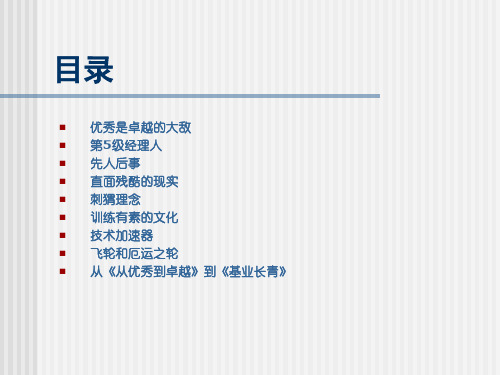
资金是运动的价值,资金的价值是随 时间变 化而变 化的, 是时间 的函数 ,随时 间的推 移而增 值,其 增值的 这部分 资金就 是原有 资金的 时间价 值
先人后事-- 人力不是最重要的财富,合适的雇员才是
报酬的高低不是公司卓越与否的关键,排在第一位的不是 你支付报酬的多少,而是你将支付给何人。
创造一种人们有无数机会被倾听的文化 氛围,多渠道获知事实
坚持你一定会成功的信念,同时,要面 对现实中最残忍的事实,不论多大困难
,不论它们是什么
资金是运动的价值,资金的价值是随 时间变 化而变 化的, 是时间 的函数 ,随时 间的推 移而增 值,其 增值的 这部分 资金就 是原有 资金的 时间价 值
富有实力的经理人 组织人力和资源,高效
地朝既定目标前进
乐于奉献的团队成员 为实现集体目标贡献个人才智,
与团队成员能力合作
能力突出的个人 用自己的智慧、知识、技能和良
好的工作作风作出巨大贡献
资金是运动的价值,资金的价值是随 时间变 化而变 化的, 是时间 的函数 ,随时 间的推 移而增 值,其 增值的 这部分 资金就 是原有 资金的 时间价 值
“在没有得到适合的人才之前,就绝口不提公司发展问题。”“我不知道将
会把公司带到何方,但我知道只要以合适的人才为起点,通过问他们一些正
确的问题和让他们进行热烈的讨论,我们完全可以找到一条令公司繁荣昌盛
的道路。”
--联邦国民抵押协会CEO 大卫.麦克斯韦
资金是运动的价值,资金的价值是随 时间变 化而变 化的, 是时间 的函数 ,随时 间的推 移而增 值,其 增值的 这部分 资金就 是原有 资金的 时间价 值
让优秀的人才完全不必担心自己的地位,可以全身心投入 到工作中去。如果让一个人成年累月处于不确定中,霸占 了他们生命中可以用来干其他事的宝贵时光,最终落得一 事无成。
从优秀到卓越(最新6篇)
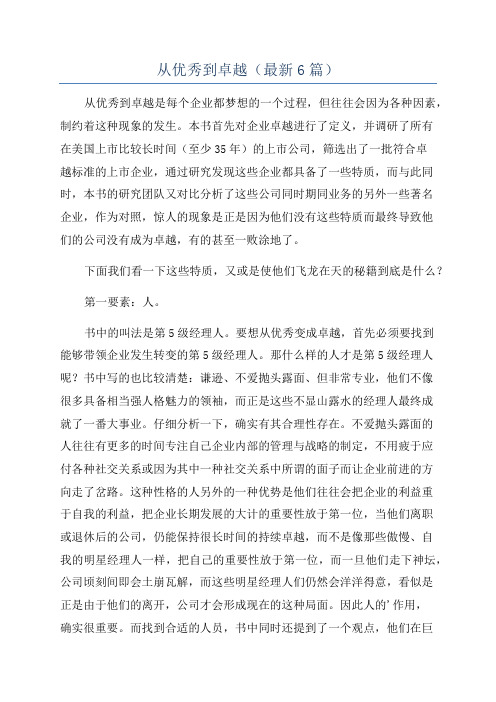
从优秀到卓越(最新6篇)从优秀到卓越是每个企业都梦想的一个过程,但往往会因为各种因素,制约着这种现象的发生。
本书首先对企业卓越进行了定义,并调研了所有在美国上市比较长时间(至少35年)的上市公司,筛选出了一批符合卓越标准的上市企业,通过研究发现这些企业都具备了一些特质,而与此同时,本书的研究团队又对比分析了这些公司同时期同业务的另外一些著名企业,作为对照,惊人的现象是正是因为他们没有这些特质而最终导致他们的公司没有成为卓越,有的甚至一败涂地了。
下面我们看一下这些特质,又或是使他们飞龙在天的秘籍到底是什么?第一要素:人。
书中的叫法是第5级经理人。
要想从优秀变成卓越,首先必须要找到能够带领企业发生转变的第5级经理人。
那什么样的人才是第5级经理人呢?书中写的也比较清楚:谦逊、不爱抛头露面、但非常专业,他们不像很多具备相当强人格魅力的领袖,而正是这些不显山露水的经理人最终成就了一番大事业。
仔细分析一下,确实有其合理性存在。
不爱抛头露面的人往往有更多的时间专注自己企业内部的管理与战略的制定,不用疲于应付各种社交关系或因为其中一种社交关系中所谓的面子而让企业前进的方向走了岔路。
这种性格的人另外的一种优势是他们往往会把企业的利益重于自我的利益,把企业长期发展的大计的重要性放于第一位,当他们离职或退休后的公司,仍能保持很长时间的持续卓越,而不是像那些傲慢、自我的明星经理人一样,把自己的重要性放于第一位,而一旦他们走下神坛,公司顷刻间即会土崩瓦解,而这些明星经理人们仍然会洋洋得意,看似是正是由于他们的离开,公司才会形成现在的这种局面。
因此人的'作用,确实很重要。
而找到合适的人员,书中同时还提到了一个观点,他们在巨大的压力下面,严峻的形式下面,他们往往会自我激励、互相鼓励,竭尽所能为公司服务,而公司的管理人员或者领导者甚至不需要对他们进行在心里上的疏导,从而又节约了大量的时间以及管理的成本。
第二要素:思想。
从优秀到卓越读后感
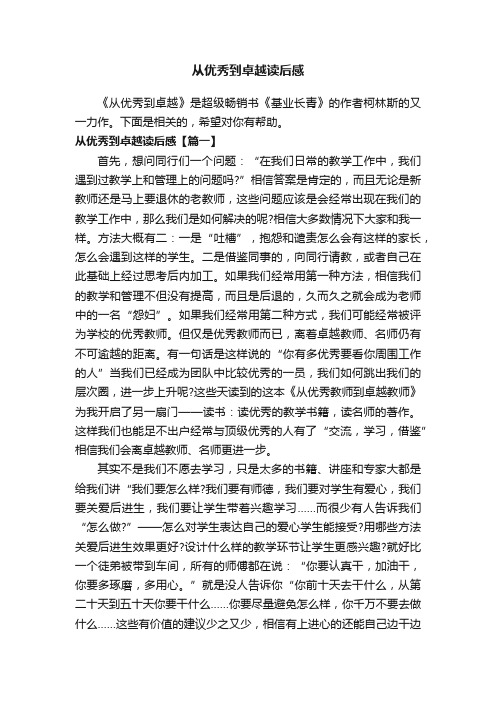
从优秀到卓越读后感《从优秀到卓越》是超级畅销书《基业长青》的作者柯林斯的又一力作。
下面是相关的,希望对你有帮助。
从优秀到卓越读后感【篇一】首先,想问同行们一个问题:“在我们日常的教学工作中,我们遇到过教学上和管理上的问题吗?”相信答案是肯定的,而且无论是新教师还是马上要退休的老教师,这些问题应该是会经常出现在我们的教学工作中,那么我们是如何解决的呢?相信大多数情况下大家和我一样。
方法大概有二:一是“吐槽”,抱怨和谴责怎么会有这样的家长,怎么会遇到这样的学生。
二是借鉴同事的,向同行请教,或者自己在此基础上经过思考后内加工。
如果我们经常用第一种方法,相信我们的教学和管理不但没有提高,而且是后退的,久而久之就会成为老师中的一名“怨妇”。
如果我们经常用第二种方式,我们可能经常被评为学校的优秀教师。
但仅是优秀教师而已,离着卓越教师、名师仍有不可逾越的距离。
有一句话是这样说的“你有多优秀要看你周围工作的人”当我们已经成为团队中比较优秀的一员,我们如何跳出我们的层次圈,进一步上升呢?这些天读到的这本《从优秀教师到卓越教师》为我开启了另一扇门——读书:读优秀的教学书籍,读名师的著作。
这样我们也能足不出户经常与顶级优秀的人有了“交流,学习,借鉴”相信我们会离卓越教师、名师更进一步。
其实不是我们不愿去学习,只是太多的书籍、讲座和专家大都是给我们讲“我们要怎么样?我们要有师德,我们要对学生有爱心,我们要关爱后进生,我们要让学生带着兴趣学习……而很少有人告诉我们“怎么做?”——怎么对学生表达自己的爱心学生能接受?用哪些方法关爱后进生效果更好?设计什么样的教学环节让学生更感兴趣?就好比一个徒弟被带到车间,所有的师傅都在说:“你要认真干,加油干,你要多琢磨,多用心。
”就是没人告诉你“你前十天去干什么,从第二十天到五十天你要干什么……你要尽量避免怎么样,你千万不要去做什么……这些有价值的建议少之又少,相信有上进心的还能自己边干边悟,没上进心的也就随波逐流了。
从优秀到卓越ppt课件

从优秀到卓越
GREAT
GOOD TO
三本书对企业经理人的 作用
《追求卓越》是激励经理人的,告诉我们什么是伟 大,提出了一个目标;
训练有素的文化
训练有素的文化,就是这样一种文化,它使自 律的人们采取规范的行为,并严格遵循三环理论, 也就是刺猬理念。概括来说,有几个要点:
要点
第一点:在纪律框架下的自由和责任。公司只 需管理系统,而无需管理员工。
要点
第二点:在训练有素的文化下,人们高度自律, 愿意全力承担责任。
要点
第三点:第五级经理人建立的是训练有素的文 化,而不是亲自做纪律维护人,单纯通过个人 权威来规范组织。
桃李不言,下自成蹊,或者说,榜样的力量是 无穷的,尤其是领导的榜样作用,更加不可轻 视。建立训练有素的文化,要首先从领导都做 起,否则将很难实行。
企业领导机制,从来就没有固定不变的和适 用一切企业的最佳模式,总是要根据环境的变 化和自身的发展进行不断的调整、改革和创新。
六 、 技术加速器和飞轮效应
必须直面残酷的事实,否则只能等死。逃避现实 不是办法,躲得过初一,躲不过十五。
四 、 创建适合公司的理 念
创建适合公司的理念就是刺猬理念,它的 精髓在于专注于一件大事,首先理解和明确公 司目标,而后制定战略,不虚张声势。
精髓
刺猬理念要求企业回答三个问题: 第一是企业在什么方面能够成为最优秀的?就 是说要搞清能做什么和不能做什么; 第二是如何找到公司发展的最大驱动力,或者 说对企业发展产生最大影响的指标是什么? 第三是公司对什么充满热情
